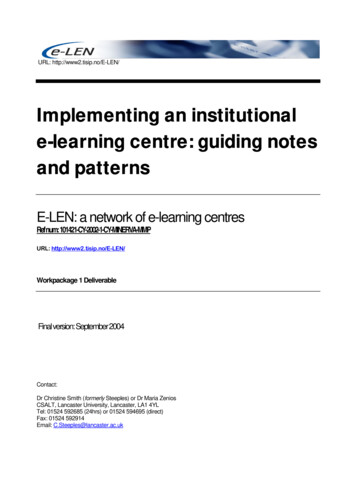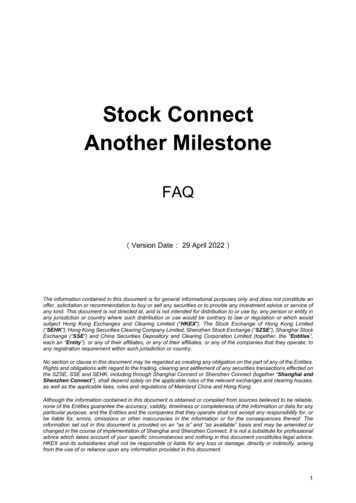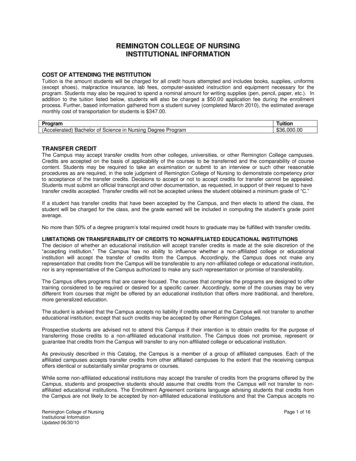
Transcription
URL: http://www2.tisip.no/E-LEN/Implementing an institutionale-learning centre: guiding notesand patternsE-LEN: a network of e-learning centresRefnum:101421-CY-2002-1-CY-MINERVA-MMPURL: http://www2.tisip.no/E-LEN/Workpackage 1 DeliverableFinal version: September 2004Contact:Dr Christine Smith (formerly Steeples) or Dr Maria ZeniosCSALT, Lancaster University, Lancaster, LA1 4YLTel: 01524 592685 (24hrs) or 01524 594695 (direct)Fax: 01524 592914Email: C.Steeples@lancaster.ac.uk
CONTENTSPart 1: Introduction to the guiding notes and patterns:1.1Who is this document for?1.2Rationale for a guiding document on implementing an e-learning centre1.3How should this document be used?1.4Origins – the E-LEN project and survey of e-learning centres1.5An introduction to design patterns and a pattern language1.6Acknowledgements1.7FeedbackPart 2: Implementing an e-learning centre: guiding notes2.1Why e-learning and what is an e-learning centre? Our opening definitions2.2An e-learning strategy2.3Setting up an e-learning centre2.4Rationale for an e-learning centre2.5Issues and challenges established e-learning centres are facing2.6Pitfalls to avoid2.7Scenarios and kinds of e-learning centre2.82.7.1Scenario for a support or service orientation2.7.2Scenario for an innovation in e-learning orientation2.7.3Scenario for a course development orientation2.7.4Scenario for a research in e-learning orientationThe need for establishing an e-learning community: internally and through external linksPart 3: Implementing an e-learning centre: organisational design patterns3.1Towards a pattern language for the organisational design of an e-learning centre2
3.23.3Patterns for potential e-learning centre purposes3.2.1A support or service role pattern3.2.2Supporting innovation in e-learning role pattern3.2.3E-learning course development role pattern3.2.4E-learning research role patternPatterns within a support or service role orientation e-learning centre3.3.1Pattern for services and activities3.3.2Pattern for human and physical resources3.3.3Pattern for e-learning centre organisation3.3.4Pattern for quality assurance and quality enhancement mechanismsPart 4: Resources for implementing e-learning centres [to be added]4.1Web sites4.2Readings relating to e-learning centres4.3ReferencesFiguresFigure 1:The structure of a design patternFigure 2:Towards a strategy for e-learningFigure 3:Aspects in an e-learning strategyFigure 4:The e-learning centre development cycle and influences upon itFigure 5:A diagrammatic representation of an e-learning infrastructureFigure 6:Evolving a strategy for development of an e-learning centreFigure 7:A schematic representation of a pattern language for e-learning centre implementationFigure 8:A schematic representation of the root for an e-learning centreFigure 9:A representation of the support or service role orientation patternFigure 10:A representation of the innovation in e-learning role of an e-learning centre patternFigure 11:A representation of the course development role of an e-learning centre patternFigure 12:A representation of the research role of an e-learning centre pattern3
Figure 13:A representation for a pattern for services and activities in a service or support role e-learningcentreFigure 14:A representation for a pattern for human and physical resources in a service or support rolee-learning centreFigure 15:A representation for a pattern for organisation in a service or support role e-learning centreFigure 16:A representation for a quality assurance mechanisms in a service or support role e-learningcentreTablesTable 1: a summary of the key distinctions and similarities between the four orientations for an e-learningcentre4
Part 1: Introduction1.1Who is this document for?This document is written for staff based in educational institutions who are wishing to set up ane-learning centre within their own institution. This includes:(a) the higher education sector (because new learning centres are being established with the aid ofexisting ones and faculty members will be informed about R&D trends, best practice etc in thee-learning field); and(b) large companies and public sector organisations which are setting up their own e-learning centres,in order to support greater and better use of e-learning for internal training and performanceimprovement purposes.We have written this booklet for people who are thinking seriously about making use of e-learningthrough the development and implementation of an e-learning centre. You may be some distance awayfrom a firm decision – wanting to know more before making choices that will have significantconsequences for how you spend your time and resources. Or you may already be committed to thispath and looking for advice about how to make a success of the enterprise. We have designed thebooklet with the idea of helping staff who are in this transition area between initial interest and fullcommitment. That said, we hope it will also be of use to people who have set up or are already in theprocess of setting up their own e-learning centre and are reflecting on what they’ve done and how itmight be enriched or improved. We also have in mind the specialist staff in educational developmentunits. We hope you may find parts of this book useful, either in improving your general understandingabout e-learning centres or in supporting staff development activities.1.2Rationale for a guiding document on implementing an e-learning centreThis document is a tangible result of our work on the EU-funded E-LEN project. (For more informationon E-LEN please see Section 1.4 below).We believe this set of guiding notes and patterns is important for the educational design work ofdeveloping and implementing e-learning centres, and to do this work in a systematic and coherentmanner. This document therefore offers a set of organisational and pedagogical guiding notes,presented as a set of design patterns, to help in the development of an e-learning centre in asystematic and rigorous way.Educational design work with current tools and methods reveals the difficulties in creating a balancebetween rigour and prescriptiveness and in finding appropriate levels of generality, such that solutionsto problems are worthy of being shared. Guidelines on best practice in educational design can bevague and unsupported by research, albeit presented as handy ‘tips and tricks’, but often they arewithout underpinning theoretical and practical rigour. Sometimes they can be too tightly prescriptive andspecified so that they are seen as relevant only to certain contexts or situations. In this document weintroduce the notion of using ‘design patterns’.Design patterns are intended to offer an alternative and flexible approach to design work that bridgesbetween theory, empirical evidence and experience, and that help resolve practical problems ineducational design. According to Frizell and Hubscher (2002) patterns are more flexible than statictemplates and yet more concrete than abstract guidelines. Patterns are proposed as a means to offerguidance but without constraining creativity.5
There are at least three reasons to justify the E-LEN project’s production of a set of guiding notes andpatterns on best practice in the implementation of an e-learning centre. The first to mention is the needto learn about the know-how, best practices, rules of thumb of implementing e-learning when neworganisations, enter the e-learning field. Despite the progress that has been made in the last five yearsin the use of information and communication technologies in education, many institutes/organisationsthat think of taking the step to implement electronic learning environments, face the problem of notknowing where to start from, nor what to do. Instead of re-inventing the wheel why not take advantageof the expertise and know-how of existing e-learning centres that has been gathered in our survey andused to produce this guiding notes and patterns document?Secondly, there is a need to identify, share and disseminate the know-how, best practices, rules ofthumb of e-learning between various organizations, already involved in e-learning. E-learning iscurrently a growing market and a field of rapid continuous development throughout the world. It isexpected that the labour market requirements of the new ‘knowledge economy’ will force highereducational organisations to extend the skills of students in respect to knowledge work, informationhandling and information and communication technology (ICT) skills. To make effective use ofe-learning methods, and to meet these changing educational needs, groups of universities and othereducational and training organisations will have to find ways of identifying and sharing best practices,collaborating in the exchange of competence, experiences, ‘lessons learnt’, tools and materials, etc.The third reason links to the need to establish more e-learning centres and enhance the existing ones.Higher educational institutes and training centres have started to establish e-learning centres. This ishappening in each of the member states, and in all of the countries of Europe, though at very differentrates of progress. There is an explicit need to create e-learning centres in each educational institution,corporate company or other organization in order to serve the ever-increasing demands forcontemporary technology-based ways of supporting learning and teaching. Furthermore existinge-learning centres can be enhanced by adopting best practices from their peers, in order to respondand adapt to the ever-changing demands for e-learning.1.3How should this document be used?We think that it’s best not to make your first steps alone. This booklet is written as if the innovative workyou are about to undertake is to be carried out by a small team, together with someone providingadministrative support and someone helping with the technological aspects.The knowledge we offer through this booklet is action-oriented but not prescriptive. Rather, we see it asa resource for sharing, discussion and critique. Before you can object that talk is a rather weak form ofaction, we would also assert that much of the key action in complex organisations is accomplishedthrough talk (Boden, 1994). At the heart of what we have to offer lie some ways of discussing andplanning co-ordinated action in the domain of e-learning. We offer some empirical and theoreticalevidence that we believe you can use to discuss, plan and manage new ventures in e-learning, such asdeveloping e-learning centres.You will find some example scenarios and worked examples as design patterns, rather than stronglyprescriptive recommendations for action. These are intended for use as raw material for thought anddiscussion. Success lies in clarity of purpose, careful alignment of goals and activities, and astrengthening intuition for what can and can’t be made to work. We can offer some good ideas but it isyour knowledge of your own context, constraints and opportunities that will be needed to transformthese ideas into local practice.Therefore, the materials we offer can best be approached as a resource for collaborative engagementwith your colleagues.The booklet is organised into four main parts: the first outlines the booklet’s purposes and rationale;while the second presents guiding notes for practitioners on implementing an e-learning centre. The6
third part presents a set of organisational patterns for designing and implementing an e-learning centre.Finally the fourth part includes information on some resources you might find useful in addition to thisbooklet.This booklet is very much an evolving one, in that as we continue to gather data from establishede-learning centres and continue to canvas for comments and feedback on these guiding notes andpatterns, this booklet will be updated and revised. The E-LEN web site will continue to provide accessto the latest edition of this document.1.4Origins – the E-LEN project and survey of e-learning centresThis document is one of the outcomes of a project funded by the EU under the Socrates programme inOpen and Distance Learning. More specifically, the funding of the project rested within the Minervaprogramme. The E-LEN project was designed to create a network of e-learning centres and leadingorganisations in the field of learning technologies. The E-LEN network is concerned with developingand delivering pedagogically-informed technology for effective e-learning experiences and has beendisseminating these experiences to other institutions. The project team included a number of peoplewho have been e-learning practitioners and researchers since the late 1980’s. So this booklet draws ontheir accumulated expertise as well as on a growing literature and on some of the outcomes of theresearch we carried out within the project.There were three main objectives for the E-LEN project and these were:1. to establish the necessary infrastructure and organisational structure for the network ofe-learning centres,2. to identify and gather best practices, “design patterns”, research roadmaps on e-learning andto enhance the dissemination of such results3. to produce guidelines on best practice for establishing e-learning centresIn this booklet, we focus mainly on the third objective, partly because that is where our core expertiselies but also because this is the area in which we have conducted research with established e-learningcentres. However, we do also focus on the second objective, in using the E-LEN work on designpatterns as a conceptual framework for our notes and guidance on establishing an e-learning centre.In order to achieve this third objective of the project relating to establishing guidelines for theimplementation of e-learning centres, the project had the following intermediate goals: to survey the administrational, managerial, pedagogical, technical, research anddevelopmental characteristics of existing e-learning centresto review current literature and partner experiences on establishing e-learning centres and thusto derive a set of organisational and pedagogical guidelines on forming their own learningcentre in a systematic way, and make these available to all interested partiesFor the purposes of the E-LEN project we have defined e-learning as:the systematic use of networked multimedia computer technologies to empower learners, improve learning, connectlearners to people and resources supportive of their needs, and to integrate learning with performance and individualwith organisational goals (Goodyear, xxxx)The following definition of an e-learning centre has been developed in the ELEN project and hasbeen used to inform the E-LEN research work:An e-learning centre is established for serving the learning needs of students, faculty and staff of aneducational/training organisation, for the deployment of innovative curriculum pedagogy and state-of-the-art learning7
technology in real courses, and for the development of new learning technologies guided by theory and validated byobservation of practiceA survey has been conducted with established e-learning centre staff. We initially conducted the surveywith E-LEN partners who have an e-learning centre in their institution, by questionnaire or telephoneinterview. The sample was then extended by surveying three e-learning centres based in UKuniversities. We are also undertaking a web-based survey, using a questionnaire to broaden the rangeand number of e-learning centres surveyed. The data from the web-based survey will be used toupdate and refine this booklet.We have used the survey findings to inform our pattern development work. The patterns are tangibleresources, planned as part of this document to augment our guiding notes for educational developers,to assist in the setting up and maintenance of pedagogically informed e-learning centres. Our originalproposal (in the E-LEN project) had been to produce a set of guidelines. We now offer this alternativedocument with guiding notes and patterns as a more practically oriented but less prescriptive approachthan a set of guidelines. In this following section we say a little more about the idea of patterns foreducational design work.1.5An introduction to design patterns and a pattern languageIn this booklet we explore using organisational design patterns as aids for the design and developmentof e-learning centres. Design patterns are being used as a means to capture and present solutions todesign problems (eg Avgeriou et al, 2003; Frizell & Hubscher, 2002). They are also being used tofacilitate communication among the members of a design team.Goodyear et al (2004) draw upon the organisational and communication framework derived fromChristopher Alexander’s work in architecture (eg Alexander et al, 1977) on pattern languages, topropose the use of patterns for participatory educational design work in higher education. Goodyear etal also identify that patterns have also been applied within the field of software engineering and discussusing patterns in the design of networked learning environments, that is, environments for e-learning. Itis asserted that designing for educational purposes such as in Higher Education, is a complex taskwhich can benefit from better tools and methods. The use of patterns offers an alternative andinnovative approach.But what do we understand by the term ‘design pattern’? According to Alexander et al, a pattern is asolution to a recurrent problem in a context. A pattern is used to:describe a problem that occurs over and over again in our environment, and then describes the core of the solution tothat problem in such a way that you can use this solution a million times over, without ever doing it the same way twice.(Alexander et al, 1977, pX)The relationships between individual patterns are important and the network created between patternshelps constitute what Alexander et al termed a ‘pattern language’. High level patterns and relatedpatterns at the same level, help provide context to lower level patterns. Lower level patterns completeand embellish higher level patterns.Goodyear et al (2004) further claim that patterns also have a teaching function, by being written in waysthat help the reader to understand enough of a problem and its solution that they could adapt thepattern to their own purposes. They have value in illustrating and explaining a recurring problem and itssolution. Alexander’s position is explicitly value laden – he refers to ‘quality without a name’ – that hisdesigns are seeking to nurture and create a convivial environment (Goodyear et al, 2004, p451).8
Patterns are being promoted and used in the E-LEN project and elsewhere (eg see the PedagogicalPatterns project website at www.pedagogicalpatterns.org/). The Pointer project is also concerned withpatterns, investigating the appropriateness of patterns as a means of communicating information ch/cseg/projects/pointer/pointer.html) Patterns can be usedas an innovative approach for teams of educational developers: eg by their use as a shared tool forcollaborative and iterative design work (Goodyear, 2004).We are using patterns in this booklet to discuss some of the key aspects concerning theimplementation of an e-learning centre within an institution, with an emphasis on the purposes andpedagogical principles that will help to successfully support such an initiative. This document thereforeconcerns the application of the pattern approach to an organisational design problem, namely that ofsetting up an e-learning centre.We have found in our work on design patterns that patterns need to be drafted, shared and critiquedthrough extensive collaborative moments: the information they present is not new or invented, rather itis derived from sharing and critiquing examples of successful solutions (Frizell & Hubscher, 2002).Indeed, Averigou et al (2003) assert:patterns are not conceived in a big band but rather discovered or mined after numerous implementations of the samesolution usually by different people. It is a process of reverse engineering the systems that embed good design, inorder to make that design explicit and to be able to communicate it to others’The development of organisational patterns for educational facilities such as e-learning centres beganwith our analysis of established e-learning centres in the E-LEN project survey (Steeples & Zenios,2003). We have used the data gathered from the survey to begin to create the organisational patternsfor e-learning centres. These organisational patterns will similarly benefit from the use of the patternapproach of collaborative sharing and critiquing. This document is therefore intended to assist teams inHE and educational organisations in working through such collaborative and iterative developmentprocesses, critiquing and embellishing the patterns to the specifics of particular contexts, ie to make thepatterns useful to particular needs and situations.Design patterns normally consist of a number of standard elements drawn from Alexander et al’s(1977) work, but adapted for our purposes in the context of educational design. A pattern normallybegins with a NAME followed by the CONTEXT for the pattern (where the pattern fits within a patternlanguage structure especially how it fits with larger patterns). The PROBLEM is next stated, followed bysome ANALYSIS of the problem. A SOLUTION is next presented, drawing upon known solutions,followed by any CONDITIONS applicable to this pattern. Finally RELATED PATTERNS are named,that is patterns that are integral to or directly associated with this NSRELATED PATTERNS9
Figure 1: the structure of a design patternThe patterns we present for implementing an e-learning centre are presented in part 3 of thisbooklet. Each pattern is organised as part of a schematic structure and featuring the followingkinds of aspects in the SOLUTION section of each pattern, eg: vision; risk assessment;educational principles; infrastructure; infostructure; support services; budget and resources;research and development; and benchmarking.1.6AcknowledgementsWe would like to thank all of the participants in our project for their generous assistance. Our thanks aredue to EU Minerva for providing a substantial part of the funding of this project, to CSALT LancasterUniversity for providing the balance of funding, and to E-LEN project partners for their advice andencouragement. We would like to thank all the individuals who gave up their time to be interviewed, therespondents to our surveys and especially those members of staff in various institutions who allowedus to disrupt their normal activities with interviews and survey materials.We would especially like to thank Alice Jesmont who has carefully transcribed all our interviews andassisted locally with project administrative matters.1.7FeedbackOne of the reasons for creating this document and making it available on the E-LEN project website –apart from any intrinsic usefulness – is that we want it to act as a magnet for additional kinds and areasof guidance, advice, experience and evidence.We would be especially glad to receive feedback from people with experience of e-learning who haveideas to share on establishing e-learning centres. Such contributions would be very valuable. We wouldalso be grateful for feedback from people who have tried using the booklet for its intended purpose. Anyimprovements we can make will be of value to future users of the booklet throughout the HE andtraining sectors.The email address to contact us is directly is Christine.Smith@lancaster.ac.uk. You can contact usdirect or express your opinions through the E-LEN website at http://www2.tisip.no/E-LEN/10
Part 2: Implementing an e-learning centre: guiding notes2.1Why e-learning and what is an e-learning centre? Our opening definitionsBefore we can really begin to rationalise the reasons for establishing an e-learning centre within aninstitution, it is perhaps worth reviewing why we feel e-learning itself is important. The growth ofe-learning is likely to be substantial through economic factors, but it is also being pushed by learnerdemands for flexibility and more learner-centred learning. E-learning is seen to offer an innovative andflexible means to support and enable quality learning and teaching.Charles Clarke’s report to DfES states:e-learning has the power to transform the way we learn, and to bring high quality, accessiblelearning to everyone – so that every learner can achieve his or her full potential. (DfES, 2003, p2)We have drawn upon this DfES consultation document of July 2003 (DfES, 2003) and the figure belowto consider the fit of e-learning to national and international trends in learning and teaching.Figure 2: Towards a strategy for e-learning (adapted from DfES presentation, 2003)A 21st century education system, according to the DfES report, needs to reflect the following five goals.It needs to:1. offer flexible provision to a diverse range of learners2. support and enable the development of a professional workforce, creating skilled graduatescapable of problem solving and creative thinking3. empower learners to make choices about how, when and where they learn and with what andwhom.4. needs to offer better value for students in supporting their learning in ways best for theirparticular needs and goals and in timely and cost-effective ways.11
5. support creativity and innovation not only in the mainstream research activities, but also inapproaches to teaching and the support of learningTo achieve these goals the report suggests a number of objectives for Higher Education Institutions(HEIs). These include for HEIs to accommodate diversity and improve the quality of teaching andlearning and to be more open, less constraining and narrowly prescriptive. It suggests e-learning canoffer important contributions to these goals and objectives by providing for: individual learning patterns with asynchronous and synchronous access to resources andguides onlinepersonalised supportcollaborative learning – whether in groups or pairsopportunities to support connections to others including remotelynew technological tools that can support innovative forms of teaching and learningvirtual environmentsflexible study offered to an increasingly diverse student populationonline communities to connect and engage with othersquality at scale, asynchronous environments in particular are scaleableA number of strategic actions are also described, designed to embed e-learning across an institution.These are actions that can affect all levels of the institution and although no explicit mention is made ofthe implementation of an e-learning centre, we would argue these actions are central goals for ane-learning centre. They include the following seven activities for an e-learning centre and its staff:1.2.3.4.5.6.7.Leading sustainable e-learningSupporting innovative uses of e-learningEducating the workforce in use of e-learningUnifying learner support in use of e-learningAligning assessment of e-learningBuilding a better e-learning marketAssuring technical and quality standards in e-learningWe feel these strategic actions help provide the incentives for an e-learning centre’s design. They areuseful to help shape the centre’s purposes and activities or roles. They suggest the following kinds ofrole for e-learning centre staff: advising, supporting, designing, developing, evaluating, promoting,researching, coordinating, filtering, and assisting. We pick up on these kinds of specific activities androles when we explore the practical implications of implementing an e-learning centre in Part 3 of thisbooklet. We describe a set of practical patterns for organisation of e-learning centres.However, in the next section, we explore further some of the key elements needed within an e-learningstrategy, of which one action we propose will be the establishment of an e-learning centre.An e-learning strategyStrategic actions need to be part of an institutional e-learning strategy. An e-learning strategy is neededgiven the scale and scope of the investment in ICT needed for effective e-learning development,implementation and take-up. A strategy also acknowledges the successes already achieved in usingICT for teaching and learning, using them to provide a strong foundation for further development work.E-learning is no longer an experiment. It has moved into the mainstream of educational design and canprovide ways to enhance the quality of the learning experience. However, institutions need to create avision of the desired end state to begin any strategic planning. A strategy needs to operationaliseactivities that will enhance the institutional core values, while positioning the institution for the demandsand opportunities of innovative technology. According to Garrison and Anderson (2003), the winningstrategy is to find relatively low-risk niche areas in which the technology can be understood andincubated and where, if there are failures, they will come early and will be less expensive.12
An e-learning strategy needs to involve consideration of the following aspects of the institutionalfunctions in terms of e-learning potential, as depicted in the figure below (figure 3).Figure 3: aspects in an e-learning strategyWe need to consider new approaches to e-learning. This includes looking at the diversity in potentialforms of e-learning available, eg: online training; courseware and simulations; knowledge managementtools; as well as access to informational databases; and the use of performance support tools.We need to consider the changing roles for students and tutors enabled by e-learning and theopportunities presented to create communities of enquiry and convivial and collegial learning spaces.We need to
2.7.2 Scenario for an innovation in e-learning orientation 2.7.3 Scenario for a course development orientation 2.7.4 Scenario for a research in e-learning orientation 2.8 The need for establishing an e-learning community: internally and through external links Part 3: Implementing an e-learning centre: organisational design patterns










